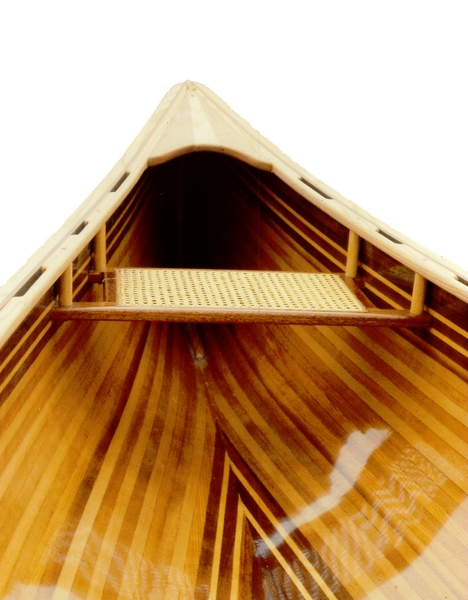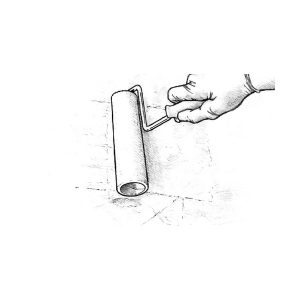
Finish coatings like paint or varnish are applied over an epoxy barrier coat to decorate the surface and protect the epoxy from sunlight. The finish coating extends the life of the epoxy moisture barrier, which in turn provides a stable base that extends the life of the finish coating. Together the two form a protective system far more durable than either coating by itself.
Protection from sunlight is a primary consideration in the selection of a finish coating. Long-term UV (ultraviolet) protection of the barrier coat depends on how well the finish coating itself resists UV and keeps its pigments or its shield of UV filters on the surface of the epoxy barrier coat. A high gloss finish reflects a higher proportion of the light hitting the surface than a dull surface. All other things being equal, a white (especially a glossy white) coating will last the longest.
Most types of coatings are compatible with epoxy. Thoroughly cured epoxy is an almost completely inert hard plastic. This means most paint solvents will not soften, swell or react with it. However, it is still a good idea to build a test panel to assure coating compatibility.
Types of Finish Coatings
- Latex paints are compatible with epoxy and they do an adequate job of protecting the epoxy barrier from UV radiation. In many architectural applications, latex paint may be the most suitable coating to use. Their durability is limited.
- Alkyd finishes-enamel, alkyd enamel, marine enamel, acrylic enamel, alkyd modified epoxy, traditional varnish, and spar varnish-offer ease of application, low cost, low toxicity, and easy availability. Their disadvantages are low UV resistance and low abrasion resistance.
- One-part polyurethanes offer easy application, cleanup, and better properties than alkyds. They are also more expensive and some may be incompatible with amine cure epoxy systems such as WEST SYSTEM epoxy, although 207 Hardener may offer better compatibility. Test first.Epoxy paints are available in one-part and two-part versions. Two-part epoxies offer many characteristics similar to higher-performance polyurethanes. They are durable and chemical resistant but offer limited UV protection compared to linear polyurethanes.

- Two-part linear polyurethane (LP) paints offer the most durable protection available. LP paints are available as pigmented or clear coatings and offer excellent UV protection, gloss retention, abrasion resistance, plus compatibility with epoxy. However, compared to other types of coatings, they are expensive, require more skill to apply and present a greater health hazard, especially when sprayed.
- Bottom paints are available in a variety of formulations. Most bottom paint systems are compatible with epoxy and can be applied directly over a prepared epoxy barrier coat. If you are unsure of compatibility or have curing or adhesion problems with specific bottom paint, use only a primer recommended for that bottom paint over the barrier coat. Follow the recommendations given for the preparation of fiberglass surfaces. Other paints including marine LPs and primers are not recommended for use below the waterline.
- Primers are usually not needed to help a paint film bond to epoxy, although interfacing primers may be required with some specialized bottom paints and high-build primers are useful for hiding scratches or flaws in the substrate. If the instructions on your paint or varnish recommend a specially primed surface, follow the recommendations given for fiberglass preparation. Self-etching primers do not work well on an epoxy coating because of epoxy’s chemical resistance.
- Polyester gelcoat is a pigmented version of the resin used to build fiberglass boats and other products. Gelcoat is sprayed into a mold before the glass fabric and resin are applied to provide a smooth pre-finished surface when the part is removed from the mold. It is not often used as a post-production finish coating, but it can be applied over epoxy and is useful in some repair situations. Refer to our Fiberglass Boat Repair & Maintenance manual (pdf), published by Gougeon Brothers, for detailed information on patching gelcoat over an epoxy repair.
Follow all instructions from the coating systems manufacturer. It is a good idea to make a test panel to evaluate the degree of surface preparation required, and the compatibility and handling characteristics of the finish system.
For detailed instruction on the application of these techniques in repair and construction, refer to specific WEST SYSTEM instructional manuals and video demos.
For complete descriptions of all WEST SYSTEM products, including selection and coverage guides, go to the Product Guide.
To help you identify and prevent potential problems associated with using epoxy, go to the Problem Solver.
For complete information on the hazards associated with epoxy and the precautions, you can take to avoid them, visit our Safety section.

